
|
Astronomy Picture Of the Day (APOD)
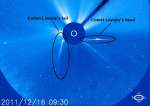 Comet Lovejoy: Sungrazing Survivor
Comet Lovejoy: Sungrazing Survivor
17.12.2011
Like most other sungrazing comets, Comet Lovejoy (C/2011 W3) was not expected to survive its close encounter with the Sun. But it did. This image from a coronograph onboard the sun-staring SOHO spacecraft identifies the still inbound remnants of the tail, with the brilliant head or coma emerging from the solar glare on December 16.
 Red Moon Rising
Red Moon Rising
16.12.2011
This surreal, wintry scene is a composite picture recorded on December 10 as the Moon rose behind the Zagros Mountains of Iran. A total lunar eclipse was already in progress. The image combines nearly 500 successive frames taken over 1.5 hours beginning in twilight as the eclipsed Moon steadily climbed above the rugged landscape.
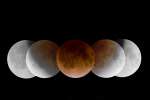 The Umbra of Earth
The Umbra of Earth
15.12.2011
The dark, inner shadow of planet Earth is called the umbra. Shaped like a cone extending into space, it has a circular cross section most easily seen during a lunar eclipse. For example, last Saturday the Full Moon slid across the southern half of Earth's umbral shadow, entertaining moonwatchers around much of the planet.
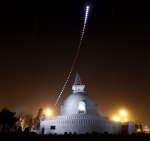 A Lunar Eclipse Over an Indian Peace Pagoda
A Lunar Eclipse Over an Indian Peace Pagoda
14.12.2011
Our Moon turned red last week. The reason was that during December 10, a total lunar eclipse occurred. The above digitally superimposed image mosaic captured the Moon many times during the eclipse, from before the Moon entered Earth's shadow until after the Moon exited.
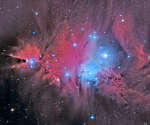 In the Vicinity of the Cone Nebula
In the Vicinity of the Cone Nebula
13.12.2011
Strange shapes and textures can be found in neighborhood of the Cone Nebula. The unusual shapes originate from fine interstellar dust reacting in complex ways with the energetic light and hot gas being expelled by the young stars.
 APOD: 2011 December 12 An Unusual Vein of Deposited Rock on Mars
APOD: 2011 December 12 An Unusual Vein of Deposited Rock on Mars
12.12.2011
What could create this unusual vein of rock on Mars? A leading hypothesis is that this thin rock layer dubbed "Homestake" was deposited by a running liquid -- like most mineral veins are here on Earth. And the running liquid of choice is water.
 APOD: 2011 December 11 Searching for Meteorites in Antarctica
APOD: 2011 December 11 Searching for Meteorites in Antarctica
11.12.2011
Where is the best place on Earth to find meteorites? Although meteors fall all over the world, they usually just sink to the bottom of an ocean, are buried by shifting terrain, or are easily confused with terrestrial rocks.
 Vesta Rocks
Vesta Rocks
10.12.2011
These colorful images are of thin slices of meteorites viewed through a polarizing microscope. Part of the group classified as HED meteorites for their mineral content (Howardite, Eucrite, Diogenite), they likely fell to Earth from 4 Vesta, the mainbelt asteroid currently being explored by NASA's Dawn spacecraft.
 Eclipsed Moon in the Morning
Eclipsed Moon in the Morning
9.12.2011
Tomorrow, December 10, the Full Moon will slide through planet Earth's shadow in a total lunar eclipse. The entire eclipse sequence, including 51 minutes of totality, will be visible from Asia and Australia...
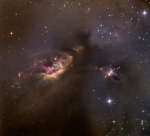 Sh2-239: Celestial Impasto
Sh2-239: Celestial Impasto
8.12.2011
The cosmic brush of star formation composed this alluring mix of dust and dark nebulae. Cataloged as Sh2-239 and LDN 1551, the region lies near the southern end of the Taurus molecular cloud complex some 450 light-years distant.
|
January February March April May June July August September October November December |
|||||||||||||||||||||||||||||||||||||||||||||||||